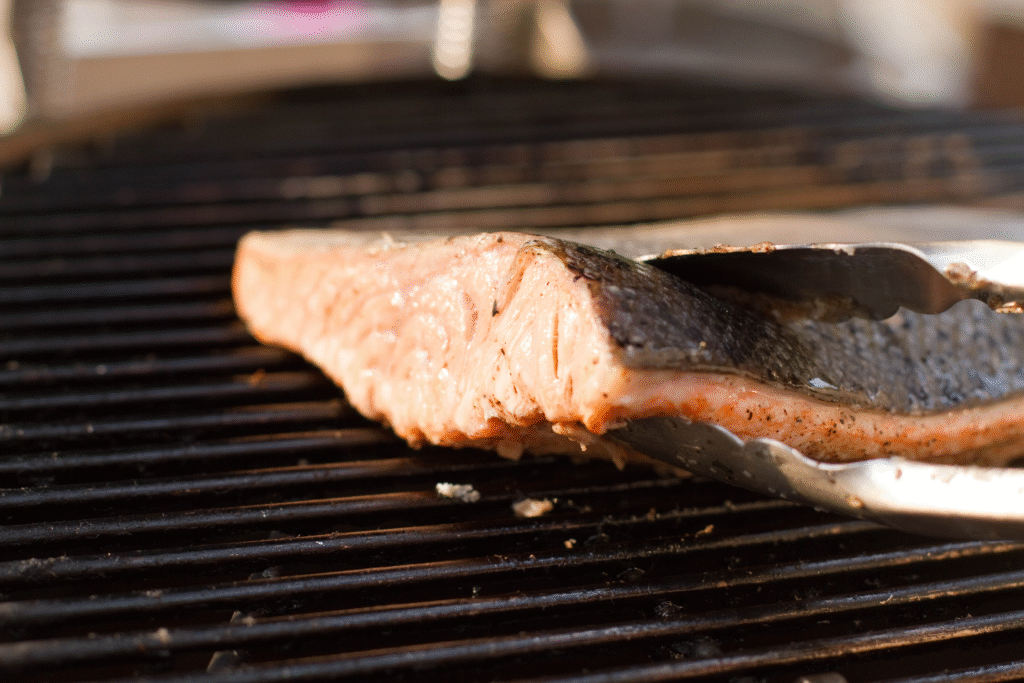Have you ever tried brine smoked salmon at a restaurant and thought, “I wonder if I could recreate that at home”? The good news is, you absolutely can! With the right technique, anyone can achieve that perfect balance of smoky flavor and tender texture. I’ve spent years perfecting my method, and the key is in the brine—this ancient curing technique enhances the natural flavors of salmon while laying the groundwork for that beautiful pellicle, which helps the smoke adhere to the fish.
Whether you prefer the slow and gentle approach of cold smoking or the quicker process of hot smoking, the brine is essential in infusing the salmon with flavor and preserving its natural oils. The result? Salmon that’s rich in omega-3s and full of complex smoky notes. After experimenting with various brining times and wood types, I’ve perfected a foolproof recipe that’s easy to adapt to your flavor preferences.
Ingredients Needed
For the Brine:
- 1 cup kosher salt (Note: if using table salt, reduce the amount to about ⅔ cup)
- ½ cup brown sugar (Light or dark works well, or substitute maple sugar for a unique flavor)
- 2 tablespoons whole black peppercorns (If using pre-ground pepper, 1 tablespoon will suffice)
- 4 bay leaves (No bay leaves? Thyme is a great substitute—use 1 teaspoon)
- 1bunch fresh dill, chopped (Dried dill can be used in a pinch—about 2 tablespoons)
- 2 lemons, zested and juiced (For a twist, orange zest works beautifully)
- 4 cups cold water

For the Salmon:
- 2 pounds fresh salmon fillets, skin-on (Wild-caught is ideal, but farm-raised will work too)
For Smoking:
- 2 cups wood chips (Alder is the traditional choice, but apple or cherry wood add fantastic flavors)
- If you don’t have a smoker, I’ll share an alternative method involving liquid smoke later.
Optional Flavor Boosters:
- 3 cloves garlic, crushed (Garlic powder works too—about ½ teaspoon)
- 1 tablespoon whole coriander seeds (Ground coriander is fine—use 1 teaspoon)
- 2 tablespoons vodka or bourbon (Optional, but adds richness)
- 1 tablespoon juniper berries (If you don’t have them, add an extra teaspoon of black pepper)
How to Make
1. Prepare the Brine
Start by combining cold water, kosher salt, and brown sugar in a large bowl. Stir the mixture for a couple of minutes until the salt and sugar are fully dissolved. Next, add the peppercorns, bay leaves, dill, lemon zest, and juice. If you’re using any of the optional boosters like garlic or vodka, toss them in now. Stir everything well to ensure the flavors are evenly distributed.
2. Prepare the Salmon
Before you start brining, carefully check your salmon fillets for any pin bones. Use tweezers or needle-nose pliers to remove them. After that, rinse the fillets under cold water and pat them dry. To ensure even brining and smoking, cut the salmon into portions about 4-6 inches long.
3. Brine the Salmon
Place your salmon portions into a glass or non-reactive container. Pour the brine over them, ensuring the salmon is fully submerged. If your fillets float, you can weigh them down with a small plate. Cover the container and refrigerate the salmon for 8-12 hours—shorter time for thin fillets (under 1 inch thick) and longer for thicker cuts.
4. Form the Pellicle
Once your brining time is up, remove the salmon from the brine and rinse it well under cold water to remove any excess salt. Dry the fillets thoroughly with paper towels. To form the pellicle, place the salmon on a wire rack over a baking sheet, skin-side down. Leave it uncovered in the fridge for 2-4 hours. The surface should feel slightly tacky to the touch, signaling that it’s ready for smoking.
5. Prepare Your Smoker
If you’re using wood chips, soak them in water for at least 30 minutes. Once they’re ready, drain them and add them to your smoker according to the manufacturer’s instructions. Preheat the smoker to a low temperature—aim for between 165°F and 175°F for cold smoking.
6. Smoke the Salmon
Place your salmon on the smoker rack, skin-side down, making sure there’s enough space between each piece for the smoke to circulate. For cold smoking (under 180°F), let it smoke for 3-4 hours. For hot smoking (around 180°F-225°F), you’ll need about 1-2 hours until the salmon reaches an internal temperature of 145°F. The salmon should be moist and tender with a deep golden color.
7. Rest and Store
Once smoked, allow the salmon to cool completely on a wire rack. Once it’s cool, wrap it tightly in parchment paper, followed by aluminum foil or plastic wrap. Store it in the refrigerator and enjoy within a week for the best flavor.
Expert Tips/Variations and Substitutions
The Perfect Pellicle
Getting the pellicle right is key for great smoked salmon. If your salmon isn’t developing that tacky surface, try using a small fan to gently circulate air around the fillets while they dry. A well-formed pellicle is slightly sticky and gives the smoke something to cling to.
Temperature Control
Keep your smoker’s temperature stable. Fluctuations can affect the quality of your smoked salmon. For cold smoking, consistency is more important than hitting a specific temperature. Always use a thermometer to monitor your smoking environment.
Salt Considerations
Salt varies in density, so make sure you’re using the right type. If you’re using Morton’s kosher salt, reduce the amount by about 25% because it’s denser than Diamond Crystal kosher salt.
The Water Test
To check if your salmon is fully brined, drop a small piece into water. If it floats, it’s ready to be smoked. If it sinks, give it more time in the brine.
Equipment Alternatives
Don’t have a dedicated smoker? No problem! Here are some alternatives:
Grill Method:
Turn half your gas or charcoal grill into a smoker by placing soaked wood chips in a foil packet with holes. Position this over direct heat and place the salmon on the cooler side of the grill.
Stovetop Smoker:
Compact stovetop smokers can work wonders for small batches. Just add your wood chips to the base and follow the manufacturer’s instructions.
Oven Method:
If you don’t have any smoking equipment, you can simulate the smoky flavor by adding ¼ teaspoon of liquid smoke to your brine. Slow-roast your salmon at 225°F until it reaches an internal temperature of 145°F.
Flavor Variations
Brining is incredibly versatile, allowing you to experiment with different flavor profiles. Here are a few of my favorites:
Nordic Style:
Add crushed juniper berries, caraway seeds, and extra dill to the brine. This creates a traditional Scandinavian flavor that’s perfect for special occasions.
Asian Fusion:
Swap out half of the water for soy sauce, then add grated ginger, star anise, and rice vinegar. This will give the salmon a rich umami profile that pairs wonderfully with rice dishes.
Maple Bourbon:
Replace brown sugar with maple syrup and add a splash of bourbon. This variation gives the salmon a sweet complexity that’s perfect for a breakfast spread.
Troubleshooting Common Issues
Too Salty:
If your salmon ends up too salty, you may have brined it for too long. For future batches, reduce the brining time by 2-3 hours and always rinse the fillets thoroughly before smoking.
Dry Texture:
A dry texture is usually a sign of smoking at too high of a temperature. Keep the temperature low and be patient—slow smoking will give you that smooth, silky texture.
Not Enough Smoke Flavor:
If the smoke flavor is too weak, use smaller wood chips or wood dust for a more intense smoke. Also, make sure your pellicle is fully developed before smoking.
Serving Suggestions
Classic Breakfast & Brunch Options
Brine smoked salmon is a brunch favorite. Try setting up a bagel bar with smoked salmon, whipped cream cheese, red onions, capers, lemon wedges, and fresh dill. For a hearty breakfast, fold pieces of smoked salmon into scrambled eggs just before they’re done for a delightful twist.
Elegant Appetizers
For a sophisticated touch, try smoked salmon canapés on rye bread with crème fraîche and a sprig of dill. Or, top cucumber slices with horseradish cream, smoked salmon, and dill for a fresh bite.
Main Course Applications
Smoked salmon works beautifully in various dishes, like a creamy pasta with peas or a luxurious salad with smoked salmon, orange segments, and a citrus vinaigrette.
Perfect Pairings
A crisp, acidic white wine like Sancerre or Albariño complements the richness of the salmon. If you prefer red, a light Pinot Noir works well. For cocktails, a classic Bloody Mary with a slice of smoked salmon makes for a perfect pairing.
